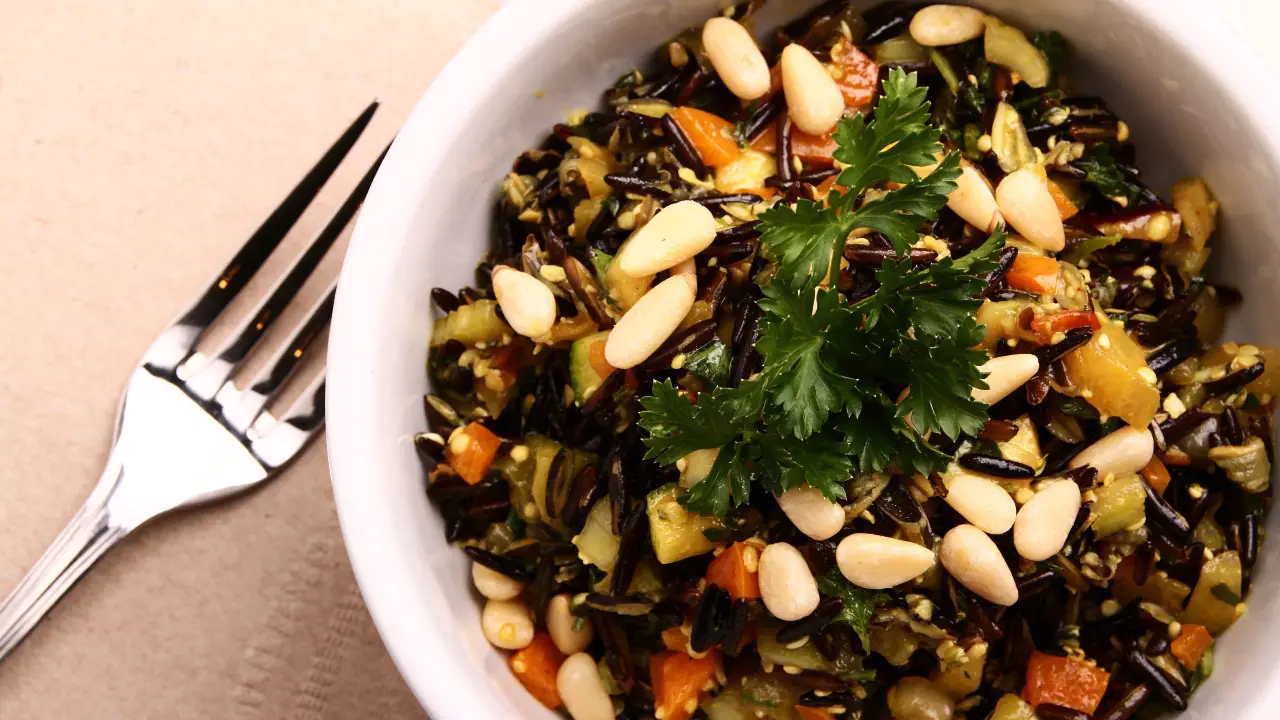Black Rice Benefits and Side Effects: A Casual Overview

ListedFit is reader-supported. When you buy through links on our site, we may earn a small commission.
Black rice, a type of rice native to East Asia, has gained popularity in recent years for its unique colour and potential health benefits.
Known for its high nutritional content, black rice contains high amounts of protein and certain antioxidants called anthocyanins, which give it its distinctive colour.
With over 200 varieties of black rice available, it has become a popular addition to healthy diets.

Quick Summary
From its origins in Asia and Africa, black rice has made its way into cuisines around the world, catering to those who appreciate both its distinctive taste and its potential health advantages.
Rich in essential vitamins and minerals, black rice serves as a good source of nutrients to support overall well-being. However, with any food, it’s essential to be aware of possible side effects and to consume it in moderation.
Key Takeaways
- Black rice offers unique health benefits due to its high protein content and antioxidants.
- Originating from East Asia, black rice has become popular around the globe for its distinct taste and nutritional profile.
- Awareness of the potential side effects and moderate consumption is essential when adding black rice to your diet.
In This Article…
The Origins of Black Rice
As I looked into the history of black rice, I found out that it has quite an interesting past. It was initially referred to as ‘Forbidden Rice’ because, during ancient China’s Ming Dynasty, it was exclusively reserved for the emperor and the royal court. Agricultural workers who were caught cultivating, selling or eating it faced serious consequences. Thankfully, nowadays, black rice is available for everyone, and we can all enjoy its unique taste and numerous health benefits.
While black rice is mostly associated with Asian regions, particularly China, it is also grown in other countries, including India, Indonesia, Thailand, and the Philippines. In these places, black rice is not only used as a staple food but also drenched in a culinary history spanning centuries.

Over time, black rice began crossing borders, and Western countries slowly started to appreciate its nutritional values. Today, it’s becoming quite popular in the United Kingdom and other European countries as people are keen to include it in their meals for a healthy option. The rise in popularity of black rice is encouraged by its marvellous taste, along with potential health benefits it can offer.
So there you have it, a casual little history of how black rice went from being an exclusive luxury to a globally beloved grain. Growing from its origins in Asia, black rice has now become a staple in many kitchens around the world, and I must admit, it’s definitely one of my favourites too.
The Nutritional Profile of Black Rice
As someone who enjoys exploring a variety of healthy foods, I recently stumbled upon black rice and its nutritional benefits. Let me share some of its standout features with you all.
First off, this superfood is a good source of several nutrients. For every 3.5 ounces (100 grams) of black rice, you’ll get around 9 grams of protein, making it one of the highest protein-containing rice varieties. That definitely caught my attention, as I’m always on the lookout for new protein sources.

What particularly surprised me were the carbohydrates and the fibre content. A quarter cup of dry, uncooked black rice provides about 160 calories and 34g of carbohydrates. Once cooked, this portion size becomes about 1/3 cup. Interestingly, it also packs in 3g of dietary fibre per serving, which contributes to 12% of the daily value. I always appreciate foods that can help me reach my fibre goals for the day.
Another key aspect of black rice that I can’t overlook is its iron content. In one serving of black rice, 6% of the daily iron requirement is supplied. This is notably beneficial for those who might be susceptible to anaemia, such as women, young children, or older adults.
Lastly, I must mention that black rice contains no sugars and is remarkably low in fat, with just 1.5g per serving. For someone like me who is mindful of their sugar and fat intake, this quality is definitely an attractive feature.
As I delved into the nutritional profile of black rice, I was pleased to discover the variety of nutrients it has to offer. From protein and dietary fibre to essential minerals like iron, it’s no wonder black rice has gained a reputation for being a nutritious and healthy choice for rice lovers like me.
Top Health Benefits of Black Rice
Black Rice and Heart Health
As someone who cares about heart health, I’ve found that black rice is a fantastic addition to my meals. The main reason for this is the antioxidant anthocyanins found in black rice, which help keep cholesterol levels low, particularly “bad” LDL cholesterol. Moreover, these antioxidants regulate total triglyceride levels to prevent atherosclerosis, a condition where fatty deposits develop in the walls of arteries.
Antioxidants in Black Rice
I particularly appreciate the abundance of antioxidants in black rice. These compounds protect our bodies from damage caused by free radicals, which can lead to chronic diseases and ageing. Since black rice is high in several antioxidants, including anthocyanins, it’s a great choice for boosting my overall health.
Black Rice for Healthy Digestion
One of the best things about incorporating black rice into my diet is that it’s a good source of both protein and fibre. The fibre content not only aids in healthy digestion but also promotes feelings of fullness, which can help prevent overeating. Additionally, it’s a good way for me to get a decent amount of iron in my diet.
Black Rice for Weight Management
As someone who strives to maintain a healthy weight, I’ve found that black rice has been beneficial for weight management. Its high fibre content can help me feel fuller for longer periods, reducing my overall calorie intake. In addition, some research suggests that antioxidants in black rice may reduce inflammation related to obesity. So, when I’m planning my meals, I don’t hesitate to include black rice as a tasty and nutritious option.
What Does Black Rice Do for Your Skin
I’ve noticed that black rice is not only a tasty and healthy food option, but it also has some great benefits for my skin. It’s packed with antioxidants, specifically anthocyanin, which helps to protect my skin from damage caused by free radicals. Those pesky free radicals are molecules that can damage skin cells, leading to premature ageing and wrinkles.
Incorporating black rice into my diet has helped fight off free radicals, keeping my skin looking younger and healthier. The antioxidants in black rice also contribute to a more even skin tone by reducing inflammation and redness.
Moreover, black rice is also a good source of protein, fibre, and iron, contributing to better overall skin health. Providing these essential nutrients helps to keep my skin nourished, hydrated, and radiant.
So, including black rice in meals isn’t just delightful for the taste buds; it’s also a way to keep my skin glowing and healthy.
Essential Vitamins and Minerals in Black Rice
As I’ve been researching and learning more about black rice, I’ve discovered some interesting facts about its nutritional content. Now, I’d like to share with you the essential vitamins and minerals that are abundant in black rice.
First off, black rice is an excellent source of protein, with 9 grams per 100 grams. This sets it apart from other types of rice, which generally have lower protein levels. It’s great for people who are looking to incorporate more plant-based protein into their diet.
Additionally, black rice is rich in dietary fibre, boasting 3 grams per serving. This helps keep the digestive system functioning smoothly and assists in maintaining a feeling of fullness. It’s superb for anyone keeping an eye on their weight or working on improving digestion.
When it comes to vitamins, black rice contains several crucial ones. For instance, it’s a good source of iron, providing 1.08 milligrams per serving. Iron is essential for our blood’s health and energy levels, making it an indispensable mineral.
Another important aspect of black rice is its antioxidant content. Antioxidants play a crucial role in combating various diseases and preventing cell damage. They are known for their anti-inflammatory properties, and they help protect the body against heart disease and cancer.
So, there you have it. Black rice is packed with essential vitamins and minerals, making it a valuable addition to a well-rounded diet. If you haven’t tried it yet, I highly suggest giving it a go for its nutritional properties and unique, delicious taste.
Possible Side Effects of Black Rice
Black Rice Allergies
I discovered that there could be a few potential side effects of consuming black rice. First and foremost, if you’re allergic to rice, then black rice isn’t suitable for you. Some people may experience symptoms of an allergic reaction after eating rice, including itchiness, swelling, and trouble breathing. So, always be cautious and consult a doctor if you suspect you might have a rice allergy.
Effects on Blood Sugar
Next, black rice has a lower glycemic index compared to white rice, which means it raises your blood sugar slower. However, it’s still a carbohydrate, so if you’re someone with diabetes, it’s essential to monitor your blood sugar levels when consuming black rice. You may need to adjust your diet or medication accordingly.
Potential Digestive Issues
Lastly, black rice is a whole grain, meaning it’s rich in fibre. While this is generally beneficial, some individuals might experience digestive problems if they’re not used to consuming high amounts of fibre. Possible issues include bloating, gas, or even diarrhoea. To reduce the likelihood of these issues, try gradually incorporating black rice into your diet, instead of consuming a large amount all at once. Also, remember to drink plenty of water to help your body process the fibre.
So, these are some of the potential side effects of consuming black rice. As always, pay attention to how your body reacts and seek professional advice if you encounter any issues.
Cooking Tips for Black Rice
I’ve recently started to cook with black rice and thought it would be a good idea to share some tips I’ve learnt. So, let’s dive into some handy cooking tips for black rice without further ado.
First things first, always give your black rice a good rinse before cooking. Since it can have some dust or debris, rinsing it helps in getting rid of any unwanted particles. Just place the rice in a fine mesh strainer and rinse under cold running water until the water runs clear.
Once you’ve rinsed your rice, the next step is to decide the method of cooking. There are a couple of ways to cook black rice, but I have found that using a rice cooker or a saucepan works the best for me. If you are using a rice cooker, simply follow the manufacturer’s instructions for the water to rice ratio. For a saucepan, the typical ratio is 1:2 – 1 part rice and 2 parts water. Bring the water and rice to a boil, then lower the heat, cover and let it gently simmer for about 30-35 minutes or until all the water is absorbed.
Now, I know this might sound a bit cheeky, but I would recommend letting your cooked black rice rest for a bit. Just let it sit for about 5-10 minutes after it finishes cooking. Why, you ask? Well, giving it some time to rest helps the rice become fluffy and evenly cooked, giving it the perfect texture.
The thing about black rice is that it can be a bit sticky, so you may want to lightly coat your rice cooker or saucepan with oil or butter before adding the rice. This tip has saved me the hassle of scrubbing stuck rice off the bottom of my cookware!
Lastly, feel free to get creative with black rice! It works wonders in salads, stir-fries or even as a colourful addition to your sushi. You can also mix it with other rice varieties to add some oomph in both flavour and appearance. Don’t be afraid to try new recipes — that’s where the fun lies!
There you have it! These are my top tips for cooking black rice. Happy cooking, and enjoy the delicious goodness of this marvellous grain!
Conclusion
In my exploration of black rice, I’ve discovered that it offers several health benefits. It’s a good source of nutrients such as protein, fibre, and iron, while being rich in antioxidants like anthocyanins, which are known to contribute to maintaining our overall health.
I found that black rice may help in boosting eye health, protecting against cancer, diabetes, and heart disease, and reducing inflammation in the body. I must note, however, that more research is needed in this area, but the initial findings look promising.
While digging deeper, I also learned that there can be potential side effects of consuming black rice, such as interactions with certain medications. It’s good practice to consult a healthcare professional if you’re considering integrating black rice into your diet, especially if you’re taking other medicines.
So, despite some uncertainties, it seems like adding black rice to my meal plan could be a great move for my health. I’m now more aware of its benefits and possible side effects, and I’m ready to give this nutrient-packed grain a try.
Frequently Asked Questions
What are the nutritional differences between black and brown rice?
As a fan of both black and brown rice, I’ve found that there are some nutritional differences between the two. Black rice is known for having a higher protein content (9 grams per 100 grams) compared to brown rice.
Additionally, black rice contains higher amounts of antioxidants called anthocyanins, which give the rice its dark colour and offer several health benefits such as protection against inflammation and oxidative stress.
Are there any side effects of consuming black rice regularly?
From my own experience and knowledge, there aren’t any significant side effects associated with regularly eating black rice.
However, moderation is key when consuming any type of food. If you’re allergic to rice or have specific dietary restrictions, it’s always a good idea to consult a healthcare professional before making changes to your diet.
Is black rice recommended during pregnancy?
I’m not a doctor, but black rice can be a healthy addition to your diet, even during pregnancy. Since it’s rich in nutrients, antioxidants, and protein, it’s generally a good option for expecting mums.
However, if you have any concerns or specific dietary requirements, I’d recommend consulting your doctor or a nutritionist for tailored advice.
How does black rice affect digestion?
In my experience, black rice doesn’t cause any significant negative impact on digestion. In fact, with its high fibre content (3 grams per 100 grams), it can promote healthy bowel movements and overall digestive health.
Just make sure to drink plenty of water to support the digestion of fibre-rich foods.
Are there any kidney-related benefits of eating black rice?
While I can’t comment on specific kidney-related benefits, black rice does contain antioxidants, fibre, and several essential nutrients that can support overall health and wellness.
Consult with your healthcare professional if you have kidney-related concerns or questions regarding the consumption of black rice.
How do the calories in black rice compare to other rice types?
Based on my understanding, a quarter cup of dry, uncooked black rice contains about 160 calories.
Once cooked, this serving size equates to roughly 1/3 cup. Comparatively, brown rice has slightly fewer calories per serving, but the difference isn’t substantial. It might be worth considering black rice as a nutritious alternative to other types of rice due to its higher protein content and unique antioxidant profile.
Author
Latest entries
 GearJuly 20, 2024Headphones and Earbuds – Tried and Tested!
GearJuly 20, 2024Headphones and Earbuds – Tried and Tested! FitnessAugust 19, 2023Yohimbe vs Yohimbine: A Quick Comparison Guide
FitnessAugust 19, 2023Yohimbe vs Yohimbine: A Quick Comparison Guide AshwagandhaJune 16, 2023Is Ashwagandha Good for Working Out? Key Benefits Explored
AshwagandhaJune 16, 2023Is Ashwagandha Good for Working Out? Key Benefits Explored Sports HeadphonesMay 25, 2023Why Your EarBuds Keep Falling Out – Quick and Easy Solutions
Sports HeadphonesMay 25, 2023Why Your EarBuds Keep Falling Out – Quick and Easy Solutions
Affiliates:
This post may contain affiliate links that at no additional cost to you, the site may earn a small commission. We only recommend products we would use ourselves and all opinions expressed on this site are our own.
General Advice:
The information provided in this article is for general informational purposes only. It is not intended as a substitute for professional advice. Always consult with a qualified healthcare professional before starting any new diet, exercise program, or making changes to your health routine.
Accuracy Advice:
While we strive to provide up-to-date and accurate information, the content in this article may not reflect the most current research or medical guidelines. We encourage readers to do further research and consult with professionals for more personalized advice.
Our Recommendations:
The products and services mentioned in any of our articles are recommended based on our independent research and personal experience. We are not sponsored by any company. We aim to suggest products and services we believe are of high quality and could be beneficial to our readers.





